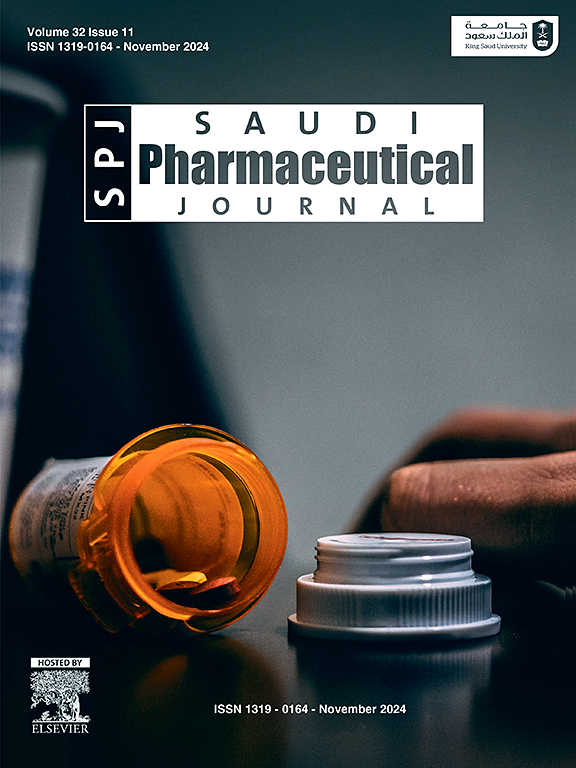Bioadhesive hybrid system of niosomes and pH sensitive in situ gel for itraconazole ocular delivery: Dual approach for efficient treatment of fungal infections
IF 3.4
3区 医学
Q2 PHARMACOLOGY & PHARMACY
引用次数: 0
Abstract
Itraconazole (ITZ) is a highly effective antifungal agent. However, its oral application is associated with systemic toxicity and poor topical use. The present study aims to improve the antifungal activity of ITZ by loading it into bioadhesive niosomes. This approach is considered to enhance the ocular permeation of ITZ, thereby boosting its efficacy against fungal infections. Therefore, it was encapsulated into niosomes (F1) and subsequently coated with hyaluronic acid (HA; F2), chitosan (CS; F3), or a bilayer of CS/HA (F4). In addition, they were further incorporated into pH-sensitive in situ gels. This dual approach is expected to increase the amount of corneal-permeated ITZ, facilitating more effective management of ocular fungal infection.
Firstly, the niosomes were prepared by hydrating proniosomes using span 60, cholesterol, and phospholipid. ITZ-niosomes showed an increase in vesicle size from 165.5 ± 3.4 (F1) to 378.2 ± 7.2 nm (F3). The zeta potential varied within −20.9 ± 2.1 (F1), −29.5 ± 3.1 (F2), 32.3 ± 1.9 (F3), and 22.6 ± 1.3 mV (F4). The high EE% values ranged from 78.1 ± 2.2 % to 86.6 ± 2.9 %. Regarding ITZ release, F1 demonstrated a high release profile, whereas bioadhesive niosomes showed sustained release patterns. Furthermore, in situ gels containing niosomes displayed excellent gelling capacity and viscosity. Remarkably, F3 laden-in situ gels (F3-ISG) demonstrated the highest ex vivo corneal permeability of ITZ and antifungal activity with a safety effect. These results indicate that F3-ISG presents a promising strategy for boosting the ocular delivery of ITZ, that could help in treating ocular fungal infections.
用于伊曲康唑眼部给药的niosomes和pH敏感原位凝胶生物黏附混合系统:高效治疗真菌感染的双重方法
伊曲康唑(ITZ)是一种高效的抗真菌剂。然而,其口服应用具有全身毒性,局部使用效果不佳。本研究旨在通过将伊曲康唑装入生物粘附性iosomes 来提高其抗真菌活性。这种方法被认为能增强 ITZ 的眼部渗透,从而提高其对真菌感染的疗效。因此,先将 ITZ 包封在 niosomes(F1)中,然后用透明质酸(HA;F2)、壳聚糖(CS;F3)或 CS/HA 双层(F4)包覆。此外,它们还被进一步加入对 pH 值敏感的原位凝胶中。这种双重方法有望增加角膜渗透 ITZ 的数量,从而更有效地治疗眼部真菌感染。首先,使用 span 60、胆固醇和磷脂水合原代物,制备出了新生物体。ITZ-niosomes的囊泡尺寸从165.5 ± 3.4(F1)增至378.2 ± 7.2 nm(F3)。zeta 电位在 -20.9 ± 2.1 (F1)、-29.5 ± 3.1 (F2)、32.3 ± 1.9 (F3) 和 22.6 ± 1.3 mV (F4) 范围内变化。高 EE% 值从 78.1 ± 2.2 % 到 86.6 ± 2.9 % 不等。在 ITZ 释放方面,F1 显示出较高的释放曲线,而生物黏附性iosomes 则显示出持续释放模式。此外,含有niosomes的原位凝胶显示出优异的胶凝能力和粘度。值得注意的是,含有 F3 的原位凝胶(F3-ISG)显示出最高的 ITZ 体内外角膜渗透性和抗真菌活性,并具有安全效应。这些结果表明,F3-ISG 是促进 ITZ 眼部给药的一种有前途的策略,有助于治疗眼部真菌感染。
本文章由计算机程序翻译,如有差异,请以英文原文为准。
求助全文
约1分钟内获得全文
求助全文
来源期刊

Saudi Pharmaceutical Journal
PHARMACOLOGY & PHARMACY-
CiteScore
6.10
自引率
2.40%
发文量
194
审稿时长
67 days
期刊介绍:
The Saudi Pharmaceutical Journal (SPJ) is the official journal of the Saudi Pharmaceutical Society (SPS) publishing high quality clinically oriented submissions which encompass the various disciplines of pharmaceutical sciences and related subjects. SPJ publishes 8 issues per year by the Saudi Pharmaceutical Society, with the cooperation of the College of Pharmacy, King Saud University.
 求助内容:
求助内容: 应助结果提醒方式:
应助结果提醒方式:


